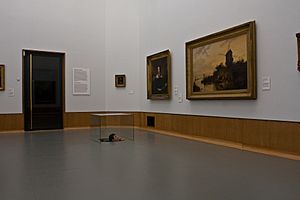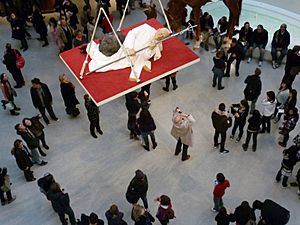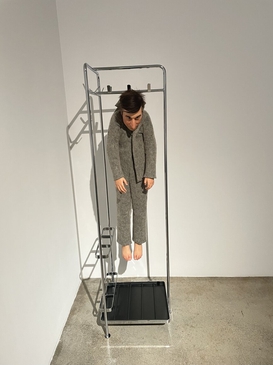Maurizio Cattelan facts for kids
Quick facts for kids
Maurizio Cattelan
|
|
|---|---|
| Born | 21 September 1960 |
| Known for | Sculpture, installation art |
|
Notable work
|
Love Lasts Forever (1997), Him (2001), La Nona Ora (1999), America (2016), Comedian (2019) |
Maurizio Cattelan (Italian: [mauˈrittsjo katteˈlan]; born 21 September 1960) is an Italian visual artist. Known primarily for his hyperrealistic sculptures and installations, Cattelan's practice also includes curating and publishing. His satirical approach to art has resulted in him being frequently labelled as a joker or prankster of the art world. Self-taught as an artist, Cattelan has exhibited internationally in museums and Biennials.
In 2011, the Guggenheim Museum in New York City presented a retrospective of his work. Some of Cattelan's better-known works include America, consisting of a solid gold toilet; La Nona Ora, a sculpture depicting a fallen Pope who has been hit by a meteorite; and Comedian, a fresh banana duct-taped to a wall.
Contents
Early life and education
Cattelan was born on 21 September 1960 in Padua, Italy. He was raised there by his mother, a cleaning lady, and his father, a truck driver. He started his career in the early 1980s by designing and producing wooden furniture in Forlì (Italy). Cattelan has no formal training in art. He has said that in addition to reading art catalogues, "making shows has been my school".
Art practice
Humour and satire are at the core of Cattelan's work; this approach has often seen him labelled variously as an art scene joker, jester or prankster. He has been described by Jonathan P. Binstock, curator of contemporary art at the Corcoran Gallery of Art "as one of the great post-Duchampian artists and a smartass, too". Discussing the topic of originality with ethnographer, Sarah Thornton, Cattelan explained, "Originality doesn't exist by itself. It is an evolution of what is produced. ... Originality is about your capacity to add." His work was often based on simple puns or subverts clichéd situations by, for example, substituting animals for people in sculptural tableaux. "Frequently morbidly fascinating, Cattelan's humour sets his work above the visual pleasure one-liners," wrote Carol Vogel of the New York Times.
Cattelan's first artwork has been noted as a photo art piece in 1989 entitled Lessico Familiare (Family Syntax), a framed self-portrait.
In 1992, Cattelan started the Oblomov Foundation (named after Ivan Goncharov's novel Oblomov and its idle main character) which raised ten thousand dollars to offer as a grant to an artist who would undertake not to make or show any work for one year. Since there were no successful applicants, Cattelan used the money for a long holiday in New York.
Cattelan is commonly noted for his use of taxidermy during the mid-1990s. Novecento (1997) consists of the taxidermied body of a former racehorse named Tiramisu, which hangs by a harness in an elongated, drooping posture. Another work utilizing taxidermy is Bidibidobidiboo (1996), a miniature depiction of a squirrel slumped over its kitchen table, a handgun at its feet.
In 1999, he started making life-size wax effigies of various subjects, including himself. One of his best known sculptures, La Nona Ora (1999), consists of an effigy of Pope John Paul II in full ceremonial costume being crushed by a meteor.
Curating
In 1999, he co-curated with Jens Hoffmann the 6th Caribbean Biennial.
In 2002, he co-founded with Ali Subotnick and Massimiliano Gioni "The Wrong Gallery", a glass door leading to a 2.5 square foot exhibition space at 516A½ West 20th street in New York City. After the building housing the gallery was sold, the door and gallery was put on display within the collection of the Tate Modern until 2009.
With long-term collaborators Subotnick and Gioni, Cattelan also curated the 2006 Berlin Biennale. Articles by Cattelan frequently appear in international publications such as Flash Art.
Publishing
From 1996 to 2007, Cattelan collaborated with Dominique Gonzalez-Foster and Paola Manfrin on the publication Permanent Food, an occasional journal consisting of a pastiche of pages torn from other magazines and submissions by artists of similar material. From 2002 he collaborated on the satirical arts journal Charley, a series on contemporary artists.
In 2009, Cattelan teamed up with Italian photographer Pierpaolo Ferrari to create an editorial for W magazine's Art Issue.
In 2010, they founded the magazine Toiletpaper, a bi-annual, picture-based publication. As part of a public art series at the High Line in 2012, Toiletpaper was commissioned with a billboard at the corner of 10th Avenue and West 18th Street in New York, showing an image of a woman's manicured and jeweled fingers, detached from their hands, emerging from a vibrant blue velvet background. In 2014, Cattelan and Ferrari produced a fashion spread for the Spring Fashion issue of New York.
In the project entitled 1968, A Toiletpaper collaboration between Maurizio Cattelan, Pierpaolo Ferrari and the Deste Foundation in Athens, Cattelan celebrates the works and time of Dakis Joannou and his collection of radical design.
Toilet Paper differs from the two previously magazine projects, as its photographs were planned and designated solely for the magazine. The level of originality for this magazine surpassed the others, providing the audience vague, oddly familiar photographs to peruse through. Toilet Paper is a surrealist pantomime of images that the viewer cannot easily trace back to a starting point, while they've most likely been conjured by popular culture. It is a whirlwind of loud colors mixed in with the occasional black-and-white photo: "the pictures probe the unconscious, tapping into sublimated perversions and spasms of violence."
Selected works

- Working Is a Bad Job (1993): At the 1993 Venice Biennale he leased his allotted space to an advertising agency, which installed a billboard promoting a new perfume.
- Turisti (1997), taxidermied pigeons and fake pigeon feces exhibited in the Italian Pavilion at the Venice Biennale of 1997
- In 1997, at the Consortium in Dijon, Cattelan dug a coffin-shaped hole in the floor of the museum's main gallery.
- Mother (1999); at the 1999 Venice Biennale, Cattelan executed this piece, a project that involved an Indian fakir, who practiced a daily ritual of being buried beneath sand in a small room, with only his clasped hands visible.
- Untitled (2001), installation created for the Museum Boijmans Van Beuningen in Rotterdam that depicts the artist peering mischievously from a hole in the floor at a gallery of 17th-century Dutch masters.
- Him (2001): a sculpture resembling a schoolboy kneeling in prayer, except that the head has been replaced with the realistic likeness of Adolf Hitler.
- As part of the 2001 Venice Biennale, he erected a full sized HOLLYWOOD sign over the largest rubbish tip on Palermo, Sicily.

- La rivoluzione siamo noi (We Are The Revolution) (2000), features a miniature Maurizio Cattelan, dangling from a Marcel Breuer–designed clothing rack. In this depiction, Cattelan contrasts the German artist Joseph Beuys statement, "every man is an artist", with his own, "I am not an artist".
- Don't Forget to Call Your Mother (2000), is a photograph by Cattelan that was utilized as a show invitation card, upon its introduction, by the Marian Goodman Gallery in New York City. "The sign ironically reminds customers of their mothers' worries each time they approach the bar to drink...in mimicking this stern parental directive, the sign draws on attitudes regarding authority, independence, and disobedience" (Susan Thompson).
- Daddy, Daddy (2008) was initially premiered in the group exhibition theanyspacewhatever (2008–09) at the Guggenheim Museum. The piece was a site-specific installation in a small pool at the bottom of the Frank Lloyd Wright atrium rotunda, where a life-size Pinocchio doll lay face-down, giving the impression that he had jumped or fallen from above.
- L.O.V.E. (2011), a 11-metre (36 ft) white marble sculpture middle finger sticking straight up from an otherwise fingerless hand, pointing away from Borsa Italiana in Milan.
- Turisti (2011), for the 2011 Venice Biennale, was made of 2,000 embalmed pigeons, not to be confused with the similarly-named Turisti (1997).
- America (2016), an 18-karat solid gold toilet, stolen from an exhibition in England in 2019.
- Comedian (2019), a banana duct taped to a wall, shown at Art Basel Miami and the edible part then there by the Georgian artist David Datuna (1974-2022) in a performance art called Hungry Artist
- Blind (2021), a memorial to the victims of the September 11 attacks, featuring black resin monolith representing one of the World Trade Center towers intersected by the silhouette of a jetliner
Exhibitions
Solo exhibitions
- Migros Museum für Gegenwartskunst in Zurich (2000)
- Centre Georges Pompidou, Paris
- The Kunsthalle Basel, Basel (1999)
- Project 65 at the Museum of Modern Art in New York City (1999)
- Castello di Rivoli in Turin (1997)
- Le Consortium, Dijon
- Hôtel des Monnaies, Paris in Paris (2017)
- Wiener Secession in Vienna (1997)
- Skulptur Projekte Münster (1997)
- Museum of Contemporary Art, Los Angeles in Los Angeles (2003)
- Museum Ludwig, Cologne (2003)
- Untitled at the Nicola Trussardi Foundation (2004)
- Breath Ghosts Blind at the Pirelli HangarBicocca in Milan, Italy (2021)
- We at the Leeum in Seoul, Korea (2023)
Retrospectives
A major retrospective titled All, assembling 130 objects of Cattelan's career since 1989, opened in 2011 at the Solomon R. Guggenheim Museum, New York. On the occasion of the exhibition, Cattelan announced his early retirement.
In 2016 the Monnaie de Paris his retrospective of his work titled Not Afraid of Love.
Biennials
Cattelan has participated in the Venice Biennale (1993, 1997, 1999, 2001, 2003, 2011), Manifesta 2 (1998), Luxembourg, Melbourne International Biennial 1999, and the 2004 Whitney Biennial in New York.
Art market
At a Sotheby's auction in 2004, Cattelan's Ballad of Trotsky (1996), a taxidermic horse suspended by ropes from a ceiling, was sold for $2 million, a record for the artist.
Recognition
Cattelan was a finalist for the Guggenheim's Hugo Boss Prize in 2000, received an honorary degree in Sociology from the University of Trento, Italy. In 2004, he was awarded the Arnold Bode prize from the Kunstverein Kassel, Germany. A career prize (a gold medal) was awarded to Maurizio Cattelan by the 15th Rome Quadriennale. On 24 March 2009, at the MAXXI Museum of Rome, singer and musician Elio came to receive the prize, claiming to be the real Cattelan.
Film
A documentary film titled Maurizio Cattelan: Be Right Back was released in 2017. The film premiered at the Tribeca Film Festival, and played in theaters in 2017. The film, directed by Maura Axelrod, featured curator Massimiliano Gioni standing in for Cattelan. It followed Cattelan's career retrospective at the Solomon R. Guggenheim Museum in New York.
Television
On the occasion of his 2011 retrospective at the Guggenheim Museum in New York, Cattelan was profiled on the American television program 60 Minutes. In 2016 a documentary about his life and work, The Art World's Prankster: Maurizio Cattelan, aired on BBC.
See also
 In Spanish: Maurizio Cattelan para niños
In Spanish: Maurizio Cattelan para niños




